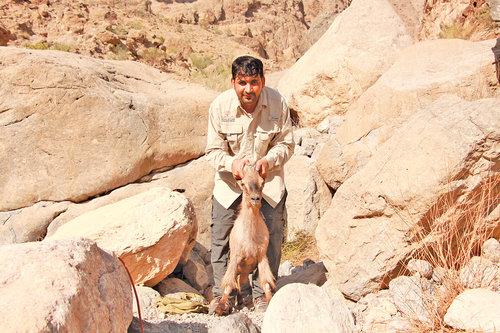
Oman- Conservators to monitor six more Arabian tahrs with tracking devices
Haitham Sulaiman al Rawahi, wildlife expert at OCE and the supervisor of the scientific research project 'Arabitragus jayakari in the eastern Al Hajar Mountains in Oman', said, 'Arabian tahr is one of the endangered animals according to the International Union for Conservation of Nature's (IUCN) Red List. It is considered one of the most important treasures of the Omani wildlife. Al Hajar Mountains is its original and one of the habitats in the world.'
'Arabitragus jayakari is characterised by its ability to live in Al Hajar Mountains, which includes Jebel al Aswad and Jebel al Abyad in the Wadi Sarin Nature Reserve and Jebel Qahwan, which is the largest gathering of the Arabitragus jayakari in the sultanate," said Rawahi."We started the project in 2012 and caught 32 animals and placed 21 satellite tracking devices. Seven devices were placed on females and 14 on males. This year we are trying to tag six more so altogether it will be 27.'
The electronic tag, placed on a collar of the tahr, transmits information related to the animal's life such as the temperature of the place in which it lives and its behavioural patterns.'These devices have the ability to remain active for a full year or two. Devices placed on females are active for close to one year. Males can carry a heavier collar compared to females and so the devices placed on them can be functional for two years.'
At the end of the stipulated time the device automatically drops as a special timer opens the belt (collar). This also happens if the animal dies or in case of predation, Rawahi said.'The device falls on the ground and sends signals to the research team. The team collects the device to retrieve the data saved in it."
The research team includes Dr Steve Rouse, Ahmed al Wahaibi and Mahmoud al Jabri.
Competition for food with other animals like donkeys and sheep, is a major challenge faced by the Arabian tahr, he said.
Arabian tahrs lost habitat and their movement was restricted after the road connecting Muscat and Dakhliyah was built. The road which passes through the Al Hajar Mountain range, divides the area into eastern and western parts.
'We are trying to understand the areas where Arabian tahr lives. We want to further our scientific study to know its daily, quarterly and annual movement patterns.'This will help us know the distance it travels, its favourite heights and right temperatures suitable for sustenance,' Rawahi said.

Legal Disclaimer:
MENAFN provides the
information “as is” without warranty of any kind. We do not accept
any responsibility or liability for the accuracy, content, images,
videos, licenses, completeness, legality, or reliability of the information
contained in this article. If you have any complaints or copyright
issues related to this article, kindly contact the provider above.
















Comments
No comment